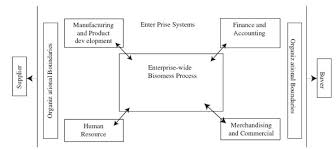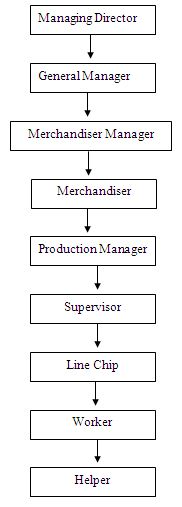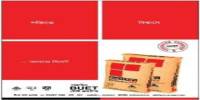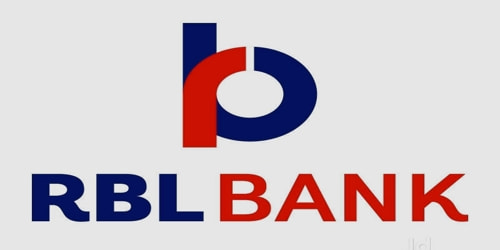Bangladesh is a developing country RMG play a vital role in our economy. Its contribution in GDP 76%. After introducing this sector in our country unemployment problem solved at some extent. Though the economy of our country is primarily agro based but without industrialization it is doubtful, whether a country like Bangladesh can break out its cycle of poverty and decrease the even loaded foreign loan.
Bangladesh has recently emerged as an important supplier of quality readymade garments in the global market. From a modest start couple of years of back, BD export of RMG increased considerably over the past few years resulted in an export earning of Tk. 99,21,80 million in financial year 2006-2007 from in earning of Tk. 59.00 million in 1980-1981. Initially the market for this product was limited to a few west European countries, which have been subsequently expanded to the U.S.A. Canada. Scandinavian, Nordic, Middle East countries. It is a fact that increasing production and export earning of RMG hold the key to save the country from the present economic depression. the sector has now occupied an important place in our national economy. But all is not well in this sector. It faces number of challenges. Because of mismanagement. To overcome this challenges, find out the problems of management system of this sector and try to solve. The numerous present study makes an attempt to identify the measure necessary solve these challenges for the greater interest of the country.
Statement of the problem
The soul of Bangladesh economy is the Garments Industry. A lions portion of export earning is gained by this sector. But after phased the Quota system it faced number of challenges the main challenge by the RMG sector of BD is production problem. Due to short supply of local fabrices and accessories this sector could not handle production smoothly. Currently the RMG sector spends approx 65% of their export earning on import of these fabrices. Last year (2005-06) our export income was 360 crore US$ but import cost for fabrices and others were 200 US$.
So to maintain the status in the global market and today’s profit the industries have to reduce production costs.
Increased productivity of the workers may reduce this costs. The owners may follow the most popular way of cost reduction which is to pay workers less and cut their facilities, it is certainly true that those are affected most of them are workers, many of them might lose their jobs and those who will still have them will be offered lower wages with fewer working facilities than now.
Objectives of Study
The main objectives of the study are as follows:
(i) Growth and developments of RMG Bangladesh of RMG Sector.
(ii) To know the management system of Bangladesh Garments Industries.
(iii) To analyse the problems of management system of Bangladesh Garments Industries and its solutions.
Scope of the term paper
The management system of ready made garments is an important issue to us because it plays an important role to the growth of our economy. It is an wide concept but I keep confined my study on of growth and developments of RMG its management system, its problems and solution.
Research Method
The Prepare a term paper on A Study on Management System of Bangladesh Garments industry: Problems and Solutions I have to accumulatate information collecting data from two sources-
(1) Primary source (2) Secondary source
I have applied questionnaire method to collect data from primary source. And I have gone through a number of books, articles & essays published in different daily newspaper, financial review etc. that are concerned with RMG sector labourers & labour law.
Definition
Readymade garments is an well known concept to all. It means to make various types of dress by cloth and thread to sell in the local market as well as in the global market. More clearly saying, the readymade garments industries are established only to manufacture usable garments.
The term garments management means the technique of controlling on garment in order to achieve its purpose or objective which is possible only when office is well organized and managed.
Review of literature
It is very hard task for me to prepare a term paper on “A Study on management system of Bangladesh Garments industries: Problem and Solution” because the time is very limited. In spite of limited time, I tried my level best to make the term paper. There are a lot of books journals, publications , weekly and monthly magazine in the market. I have taken help from such type of sources to make the term paper. The name of the sources are Rezaul and Brothers, Kyatex apperal management, Sliknit Garment, Pacific Garments, Dada garments etc. I have also collected some information’s form the employees of Chaity garments at Uttara in Dhaka. I have gone through some articles and journals to make the term paper. I also have collected some data and information’s from the internet. The mentionable journal that I have gone through to make this term paper are the journals of NAEM, Problems and prospect of RMG sector of Bangladesh – A report of BGMEA research cell on oct. 2005, Bangladesh export statistics 2005- 2006 Dhaka Bangladesh.
Limitation of the study
I have faced some practical problems in writing this paper. I was not able to make the study much informative, resourceful and analytical. During the FTC course, participants are not allowed to work outside to conduct survey for a long time mainly due to time constrains. It was not possible for me to give full attention to work on this research. On the other hand, I could not go to collect primary data from different industry, Workers and owner. Relevant books and information’s are not available in the NAEM library. So there are a lot of limitations to prepare the Term Paper.
Growth and Development of RMG
Against the backdrop of over population, under employment and mismanagement in public sector resulting in financial burden on the nation, the export oriented garment sector emerged as the savior assuring job opportunity for the unemployed and foreign exchange earning to the nation. Entrepreneurs without any help and guide line from any Govt. agency developed this sector exclusively with their own efforts,’’ In early 70’s garment as a prospective industry was unknown both to our economic planners and entrepreneurs. In mid 70’s when some of the developing countries of South East Asia like Taiwan, Hongkong, South Korea were shifting into the manufacture of High tech” products, manufacturing of basic and labor incentive products were being shifted to lesser developed countries of the region. This was mainly due to phenomenal increase in labor cost in the Readymade Garments house of Korea, Hongkong and Taiwan. In this circumstance, many companies had gone out to per capita income. In this context BD was targeted
The growth of Garment industries in BD is comparative recent one. During the British period, there was no Garment factory in this part of the Indo-Pak subcontinent. In 1960, the first Garment industry in BD was established at Dhaka and till 1971 the number rose to five. But these Garment factories were intended to serve domestic market only. In the years 1976 and 1977, some entrepreneurs came forward to set up 100% export-oriented Garment factory. Mr. Reaz of Reaz Garments and Mr. Ashrf of Asharf Garments are the pioneers of this sector and started their Garment business much earlier. However the revaluation in this sector came in eighties. Since then, the Garment sector of BD has been playing a dominant role to shape its economy and export trade. After the liberation of BD, when the countries traditional items of port could not yield expected result, in the late 70’s the Govt. and a section if entrepreneurs young, educated and dynamic began to emphasize on the development of non traditional items of export. Starting in the late seventies, the Garment sector of BD came into prominence in the middle of eighties. During the last six years, this sector marched onward from its stage of adolescence into matured childhood. By the year 1983, Readymade Garment (RMG) emerged to be a non traditional export-oriented sectors most promising in the socio-economic context of the country. By that time, those entrepreneurs felt the necessity of a sect oral trade body, non Govt. in nature, free from traditional bureaucracy, to help the RMG sector and boost up the foreign exchanges earnings of the country urgently needed at that time. Responding to that necessity, 19 RMG manufacturers and exporters joined together and by their untiring efforts got Bangladesh Garment Manufacturers and exporters Association (BGMEA) in corporate on February 20, 1983. Today it proudly declares registered membership of Garment manufacturers and exporters, To establish a healthy business environment for a close and mutually beneficial relationship among the manufacturers, exporters and importers in the process ensuring a steady growth in the foreign exchange earnings of the country. Now BGMEA has been playing a very strong role for development of RMG sector.
The RMG sector of BD is characterized by small, medium and a few large private owned enterprises, which manufacture goods mainly under contract, as per the foreign buyers designs and specifications. While there were 21 units in the country in 1981, the number of units increased to 3000 in 2000. the following table-1 shows the trends of the growth of RMG sector in BD during a period from 2000-2006. the highest growth was in 1993 due to increase of buyers order surprisingly and liberal govt. policy. Moreover, a number of conducive factors may have helped to-
Year wise growth of RMG Unites
Year | Number of RMG Factories | Growth rate |
2000 | 3000 | |
2001 | 3200 | 11% |
2002 | 3500 | 14% |
2003 | 3700 | 11% |
2004 | 3900 | 11% |
2005 | 4000 | 5.5% |
2006 | 4050 | 2.5% |
Source :- Research Cell of BGMEA
Rapid growth of RMG sector: The factors are as follows : (i) Average high educational background of entrepreneurs who took up garment business, (ii) Relative low capital base (iii) Short gestation period (iv) Easy and liberal bank loan, (v) Easy availability of technical know-how, (vi) Related chief and easy labor, (vii) Appropriate Govt. supports i.e. easy sanctioning procedure from dept. of Textile, bonded warehouse facilities, simplification of administrative procedure, introduction of back to back letters of credit (L/C) facility, tax holiday, allowing import of capital machinery at nominal rate of duty, arrangement of trade delegations and participation on export fair to promote business, arrangement of textile agreement with EEC i.e. issuing textile Certificate of Origin, Concluding of agreement with USA to protect Bangladeshi exporter and (viii) High demand of readymade garments product.
Contribution of the RMG Industry
RMG business started in the late 70s as a negligible non-traditional sector with a narrow export base and by the year 1983 it emerged as a promising export earning sector; presently it contributes around 75 percent of the total export earnings. Over the past one and half decade, RMG export earnings have increased by more than 8 times with an exceptional growth rate of 16.5 percent per annum. In FY06, earnings reached about 8 billion USD, which was only less than a billion USD in FY91. Excepting FY02, the industry registered significant positive growth throughout this period. In terms of GDP, RMG’s contribution is highly remarkable; it reaches 13 percent of GDP which was only about 3 percent in FY91. This is a clear indication of the industry’s contribution to the overall economy. It also plays a pivotal role to promote the development of other key sectors of the economy like banking, insurance, shipping, hotel, tourism, road transportation, railway container services, etc. A 1999 study found the industry supporting approximately USD 2.0 billion worth of economic activities (Bhattacharya and Rahman), when the value of exports stood at a little over USD 4.0 billion.
One of the key advantages of the RMG industry is its cheap labour force, which provides a competitive edge over its competitors. The sector has created jobs for about two million people of which 70 percent are women who mostly come from rural areas. The sector opened up employment opportunities for many more individuals through direct and indirect economic activities, which eventually helps the country’s social development, woman empowerment and poverty alleviation.
Management System of RMG
There is a managing committee to operate each garment. Managing director is the head of that committee and to help him there are different officers in different post According to the power and function the highearcy are given below :
Most of the time the Garments owner is the MD. MD manages his garment in his own way. the have no specific management system to operate the garments (Except some sector government policy have not for them to operate the garments). After receiving the order confirmation detail from the buyer, a fail maintain customer details. After than the commercial negotiate with the buyer and fixed the price. If Buyer accepts price Performa invoice ins sent and following steps are taken by the owner to maintain buyer order.
In somewhere they follow the government role. But most of the sector they have no government role. So the owner of the garments manage their garments in their own way. After phased quota they are facing terrible challenge. Most of the time they thought about only their profit not workers affairs. Doing this the relationship between owner and workers became hot. The workers called Darmaghot. The production was hampered and the shipment was canceled. The owner faced a lot of problem such as-
1. The shipment was canceled and the buyer refused to buy their production.
2. To maintain the profit the owner try to reduce production cost and doing that they give the worker poor wages.
3. They try to enter the chilled labour at a poor wages. Labour Law can not follow and the owner do not allow them to do trade union.
4. Sometime they face some problem to open L/C in the bank and it is also a great problem to receive raw materials in time due to customs complexly or delay.
5. The job security of the worker in RMG sector is not ensured. Because labor low & ILO convention to are not strictly followed.
6. Majority of the workers have no appointment letter. So the owners enjoy the power of discharging or dismissing a worker from his job anytime.
7. Though a wages structure for the workers has been made recently, but its not followed by to all the owners.
8. The workers have no professional satisfaction.
There are a number of reasons such as, (i) They are not granted necessary for recreation. (ii) They are Poorly Paid. (iii) Some times they are not given bonus. (iv) There is hardly a daycare center for the children of workers. (v) Want of necessary cafeteria, hygienic sanitary system, active give management system an health facility.(vi) Very often female workers are disturbed or physical exploited by their male colleagues, authority or local miscreants, For this out women workers become victim of social humiliation. In many cares this issue maker their conjugal life unstable. (vii) The facility of training for the workers is very insufficient in RMG sector.
Government Policies
Recently the Govt. has taken some policies, which will also further argument the smooth growth of RMC sector.
(a) Permission for importing gray fabric under back to back L/C by both dying and printing industries as well as by garment industries.
(b) Permission for importing washing raw materials under back to back L/C.
(c) Import of duty free capital machinery.
and allowing the BGMEA to issue permission to import raw materials for the garment industries.
(d) In 2005 “Social compliance forum for RMG” is established to improve working environment, to ensure safety and to give lawful facilities to the workers of RMG. The process of materializing the decisions undertaken by that forum is going on with the help of two issue-based task force-Task Force on Labour welfare in RMG & Task force on occupational safety in RMG -and CMC of EPB.
(e) To ensure different Privileges of workers a treaty is signed among the owners of RMG, workers of RMG & the Govt. At present, 10 conditions as per the treaty are in process of being materialized. For example, (i) 15 teams and 13 teams formed by Labour and Employment Ministry & BGMEA respectively are working.
(f) To ensure safety against fire and upgrade working environment of RMGs 13 teams formed by Home Ministry are visiting the RMGs.
(g) The concerned Ministries or offices are working to ensure minimum wages as per the declaration of Wages Board.
The minimum wages rate of the garments workers is mentioned below:
| Classification of workers | Monthly basic wages | Monthly house rent allowance (30% of the basic wages ) | Monthly medical Allowance | Total amount (Per month) |
| Grade- 1 | 3800.00 | 1140.00 | 200.00 | 5140.00 |
| Grade-2 | 2800.00 | 840.00 | 200.00 | 3840.00 |
| Grade-3 | 1730.00 | 519.00 | 200.00 | 2449.00 |
| Grade-4 | 1577.00 | 473.10 | 200.00 | 2250.10 |
| Grade- 5 | 1420.00 | 426.10 | 200.00 | 2046.00 |
| Grade-6 | 1270.00 | 381.00 | 200.00 | 1851.00 |
| Grade-7 | 1125.00 | 337.50 | 200.00 | 1662.50 |
The minimum wages rate for the garments workers of different ranks, 2006. Source: Bangladesh Labour Law, 2006.
(h) 20 crore has been allocated in the budget of FY 2005-06 for the purposes of creating employment through alternative training in different areas if workers loose their jobs due to negative impact in the quota free regime.
(i) The following Articles of “Bangladesh Labour Law, 2006” Support the cause of workers:
1. The owner cannot retrench a worker without notice who has worked
continuously a year. Article 20.
2. An adolescent worker must not work more than 5 hours a day and not above 30 hours per week. In addition, he/she can work total 36 hours (including over time duty) per week, not more than that, iii. Articles 45 to 49 deals with maternity leave and some other facilities that a female worker will be allowed to enjoy at pregnancy period.
3. Articles 51 to 60 deal with health management. Specially cleanliness (article 51), proper ventilation system and ideal temperature (article- 52), removal of dust & smoke (article 53), necessary light (article-57), pure drinking water (article-58), proper sanitation system (article-59) & wastage box (article-60) must be ensured by the owners.
4. Articles 61 to 78 focus on security system. For instance, to ensure security of the workers cautious measures against dangerous smoke & fire, strong and firm lift, wide floors & stairs etc are essential.
5. A plan has been taken to child labour totally form SAARC countries within 2010.
Research Findings
i) The main challenge faced by the RMG sector of BD is production problem. Due to short supply of local fabrics and accessories, this sector could not handle production smoothly,
ii) Lack of skilled workers etc, arc the main factors for hampering production and delivery of goods.
iii) Due to Cumbersome custom formalities, delay in quota distribution, failure to deliver order in time, sudden change of order by the buyers, mischievous role of the buyers agents and etc., the RMG sector have been facing challenges in the marketing of their products. Except proper marketing a manufacturer can not operate his business smoothly.
iv) Another challenge encountered by the garment sector and BGMEA was the child labour issue which arose in 1994 when some major buyers mainly USA had threatened to boycott local garments on the issue of employment of child labour in garment factories.
v) For the development of smooth global marketing of garments, side by side with the expansion of garment industry in BD, the service of air express industry also developed.
vi) 60% workers earn 1600-2000 tk. per month, 40% workers earn 1200-1600 tk. and only 10% workers earn above 2000 tk.
vii. None of the workers’ working hour is in consistent with Bangladesh Labour Law, 2006 or International Labour Law. Because everyday 30%, 60% and 10% of them work for 10 hours, 12 hours and above 12 hours respectively.
viii. About 67% female respondents have said that the working environment is not safe. And about 33% of them speak about physical & mental harassment by the male colleagues & authority.
Recommendations
A training Institute with necessary facilities and support should be setup to impart exclusive training on garments business. Bangladesh Management – Development Center (BMDC), Bangladesh Institute of Administration and Management (BIAM) and Textile Institute may offer certificate courses on different aspects of RMG though a fashion institute has been set up under BGMEA.
- Bangladesh need to restructure its textile and RMG industries with appropriate backward and forward linkages and improve substantially its labour productivity and efficiency. It must implement well-formulated cost reduction and product diversification strategies.
- The economic and social status of the garment workers should be upgraded, then it will have a tremendous effect of the production and consumption in the economy.
- The exporter should maintain all the rules and regulations and the quality of Bangladeshi RMG should be increase to survive in the global market.
- Duty on garment spares should be reduced and the production cost should be minimized,
- The new wages-structure for the garments workers must be fully implemented as soon as possible.
- To improve working skill of the workers more training programmes should be arranged.
- In the garments rehearsal of taking preventive step against fire should be held regularly so that no workers die being fire burnt in future.
- To give health service to the workers the owners have to ensure onducive working environment by facilitating strong lift, sufficient light, proper ventilation system, sanitation system etc.
- the workers should be allowed to enjoy weekly holiday and other govt. holidays.
- Each & every workers must be provided appointment letter and given relief from the fear of being retrenched any time. Thus their job security should be ensured.
- The workers must be given opportunity to participate in constructive Trade Union.
Conclusion
The Garment sector has tremendous impact on socio-economic structure of the country. It also brings economic prosperity for the poor women. We believe that there must be a saturation point for any industry. But for our garment industry, still we are away from it. With the conclusion of the Uruguay round of negotiations, the MFA was phased out. We are in the free trade regime of the GATT. In that situation, without BD’s own fabrics, it would be very difficult for BD to even retain its present position in the quota free developed countries, not to speak of any further growth. A developing country like BD is expecting much more from the promising garment sector, the sector which assures job opportunity for the millions of unemployed and much needed foreign exchange earning for the country. After entering in a new Quota free market BD faced a big competition with many countries like China, Vietnam, Cambodia and some Caribbean countries where labour are very chief. So the manufacturers should keep it in their mind that without quality control, cost control and timely shipment they can never compete with the competitors and survive in the global market of RMG. So, they should be changed their management system for the well being of their garments. Again we should keep it in our mind that the workers employed in the Garment factories are given suitable wage and other facilities, the labour unrest might swallow up the industry wholly including the proprietors. Hence timely .and adequate action is to be taken for solving the problems with which the industry has now been plagued. The Govt. also is anxious to save the foreign exchange earning garment industries from falling into the clutches of dishonest trade union leaders who are a new breed of exploiters. If the garments sector collapses due to lack of policy support of the Govt. and manufacturers, the sector will lose the global market and Dhaka City would turn to a ghost city. As a result the total social stability will tumble as millions of people directly or indirectly make their living from the sector. The families, which depend on this sector for their existence, will be unseated from employment and deprived of their only means of survival.

















